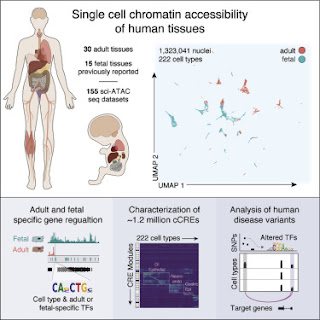This is my sixth post on the complete telomere-to-telomere sequence of the human genome in cell line CHM13 (T2T-CHM13). There were six papers in the April 1st edition of Science. My posts on all six papers are listed at the bottom of this post.
The new long-read and ultra-long-read sequencing techniques have revealed the organization of centromeric regions of human chromosomes. The basic structure of these regions has been known for many years [Centromere DNA] but the overall arrangement of the various repeats and the large scale organizaton of the centromere was not clear.
The core functional regions of centromeres consist of multiple copies of tandemly repeated alpha-satellite sequences. These are 171 bp AT-rich sequences that serve as attachment sites for kinetocore proteins. The kinetochore proteins interact with spindle fibers that pull the chromosomes to the opposite ends of a dividing cell. The core region is surrounded by pericentromeric regions containing additional repeats (mostly HSat2 and HSat3). The alpha-satellite repeats take up almost 3% of the genome and the pericentromeric repeats occupy an additional 3%.1 That's why centromeres are a major component of the functional part of the human genome. (Centromeres are classic examples of functional noncoding DNA and knowledgeable scientists have known about them for half a century.2
Altemose, N., Logsdon, G.A., Bzikadze, A.V., Sidhwani, P., Langley, S.A., Caldas, G.V., Hoyt, S.J., Uralsky, L., Ryabov, F.D., Shew, C.J. and et al. (2021) Complete genomic and epigenetic maps of human centromeres. Science 376:56. [doi: 10.1126/science.abl4178] Existing human genome assemblies have almost entirely excluded repetitive sequences within and near centromeres, limiting our understanding of their organization, evolution, and functions, which include facilitating proper chromosome segregation. Now, a complete, telomere-to-telomere human genome assembly (T2T-CHM13) has enabled us to comprehensively characterize pericentromeric and centromeric repeats, which constitute 6.2% of the genome (189.9 megabases). Detailed maps of these regions revealed multimegabase structural rearrangements, including in active centromeric repeat arrays. Analysis of centromere-associated sequences uncovered a strong relationship between the position of the centromere and the evolution of the surrounding DNA through layered repeat expansions. Furthermore, comparisons of chromosome X centromeres across a diverse panel of individuals illuminated high degrees of structural, epigenetic, and sequence variation in these complex and rapidly evolving regions. The details of the organization of each centromere aren't important. There's a lot of variation between centromeres on different chromosomes and between specific centromeres in different individuals. The authors looked at the organization of X chromosome centromeres in a variety of different individuals from different parts of the world. As expected, there was considerable variation and, as expected, there was more variation within Africans than in all other populations combined. It shouldn't come as a surprise to find that the authors want more T2T sequences. This high degree of satellite DNA polymorphism underlines the need to produce T2T assemblies from genetically diverse individuals, to fully capture the extent of human variation in these regions, and to shed light on their recent evolution. I really hope the granting agencies don't fall for this. It would be much better to spend the resources on exploring the biological function of splice variants (alternative splicing?) and putative noncoding genes in order to resolve the junk DNA controversy. It would also help to devote some of this money to the proper education of science undergraduates. The authors claim to have discovered 676 genes and pseudogenes within the centromeres. They claim that this includes 23 protein coding genes and 141 lncRNAs genes. They present evidence that three of these genes might have a function which means that 161/164 of these "genes" are "putative" genes until we see evidence of function.3 1. It's unlikely that most of this 6% is absolutely required for the proper functioning of the centromeres because there are many individuals with much less centromere DNA. That's why I only attribute about 1% of the genome to functional centromere sequence. 2. Unknowledgeable scientists continue to be shocked when they discover that noncoding DNA can have a biological function. This is because they weren't taught properly as undergraduates. 3. I don't understand why so many scientists are unable to see the difference between a putative gene and a real gene.














